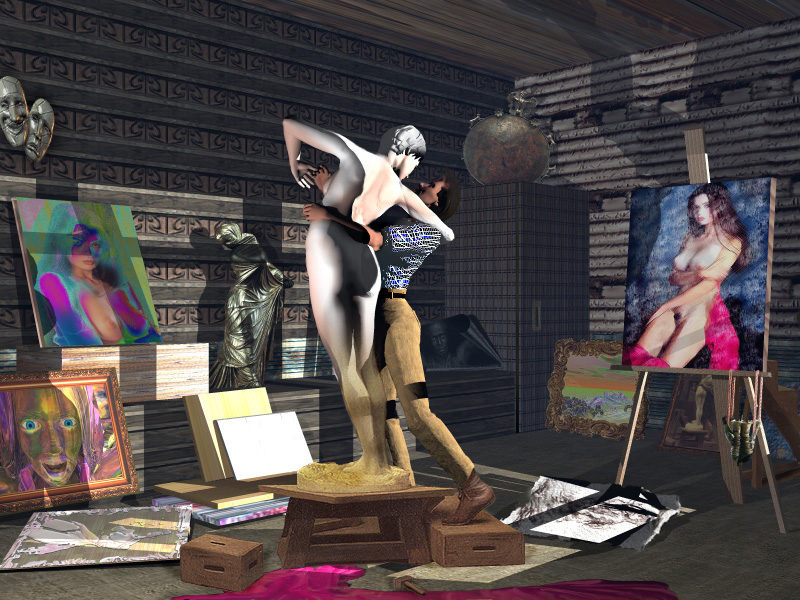 |
||
Finding Galatea: A Self-Portrait
1999 © Tobin James Mueller
"Finding Galatea" was rendered in Bryce 4, with editing in Photoshop 5.5.
For more details, see below.
This image was inspired by the 1890 oil masterpiece, "Galatea and Pygmalion," by Jean-Léon Gérome.
Based on the Greek myth: The artist Pygmalion was on a quest to sculpt his ultimate vision
of womanhood. Seeing the beauty of his final sculpture, he fell in love.
Aphrodite, the Goddess of Love and Beauty, felt pity for the lovesick artist and,
breathing life into the statue, united Galatea and Pygmalion. Also, Tobin chose
this subject to pay homage to the incredible book, Galatea 2.2, by Richard Powers.
As suggested by the artist's subtitle, "A Self-Portrait," there are many personal images in this painting.
The face of the rendered artist is, indeed, a self-portrait. Other paintings and images around the room
are also Tobin's originals, except for the portrait on the easel
and a copy of the original Gérome oil, partially hidden beneath the easel.
The cracked masks of Comedy & Tragedy hanging on the wall represent Tobin's playwriting
(he is a member of the NYC Dramatis Guild). The half-rolled scroll in the back is a
portrait of Miles Davis, representing Tobin's career as a composer and music innovator.
Other elements of note: The use of shadow is symbolic; a double cross projected on the back wall
connects two views of womanhood; also, the figure of Galatea seems to be emerging
from shadows into the arms of the artist, as if the act of the kiss is turning her marble into flesh.
The foreground red garment gives the impression of pooling blood, looking as if it has
come from the figure of beauty above, or from the act of creation taking place;
it is also like a lover's garment thrown to the floor in passion;
or, a curtain fallen from a work of art suddenly revealed. Note also
the similarity bewteen the artist's pants and the marble legs of the statue:
It is as if they have grown from the same clay...
This scene is reminiscent of Tobin's award-winning poem, The Singer: Psalm IV,
from his collection, Ash (1998-99). And, lastly, the bright empty canvas at the lovers' feet
represents the works still unmade, the infinite possibilities of human imagination,
and the starting point of both art and human relationships: an empty canvas.
The wall and ceiling textures are by Nicholas Marks at FreeTextures.
Digital Art Gallery | Other ArtsForge Artists | Xianu Worlds & Terrains
ArtsForge Main Page | VisionForge | WordForge | MusicForge
Tobin James Mueller's Featured Gallery | CyberCards
All words and images appearing anywhere on the ArtsForge site are the exclusive property of the creating artist.
